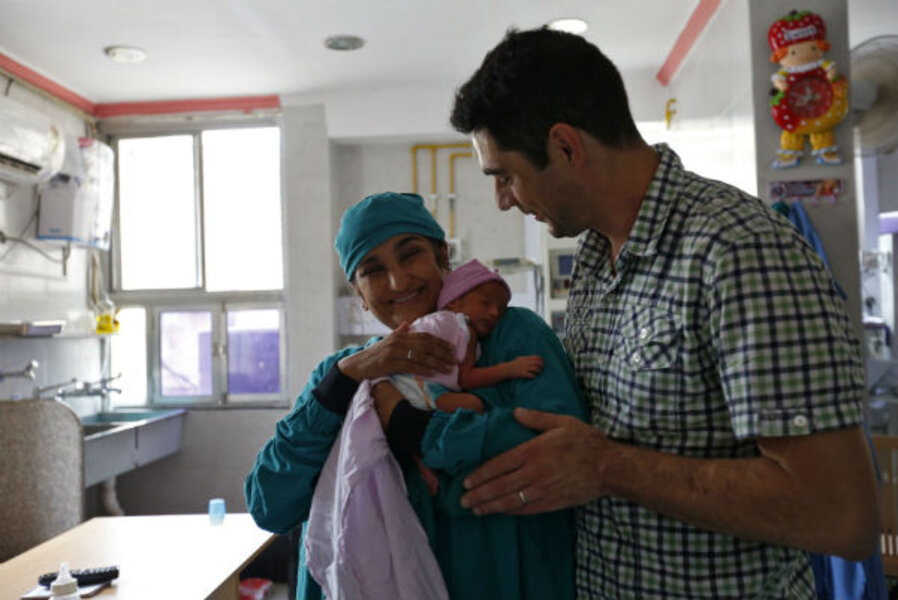India’s seeks to regulate commercial surrogate industry
Loading...
| Anand, India
Dressed in a green surgical gown and cap, British restaurateur Rekha Patel cradled her newborn daughter at the Akanksha clinic in northwestern India as her husband Daniel smiled warmly, peering in through a glass door.
"I can't believe we have our own child at last," said Patel, 42, gazing in wonderment at five-day-old Gabrielle.
"We are really grateful to our surrogate mother who managed to get pregnant and kept our little daughter healthy. She gave nine months of her life to give us a child."
It is the perfect promotion for India's booming surrogacy industry that sees thousands of infertile couples, many from overseas, hiring local women to carry their embryos through to birth.
But a debate over whether the unregulated industry exploits poor women prompted authorities to draft a law that could make it tougher for foreigners seeking babies made in India.
"There is a need to regulate the sector," said Dr. Sudhir Ajja of Surrogacy India, a Mumbai-based fertility bank that has produced 295 surrogate babies – 90 percent for overseas clients and 40 percent for same-sex couples – since it opened in 2007.
"But if the new law tightens rules as suggested by the ministry of home affairs, which disallows surrogacy for same-sex couples and single parents, then it will clearly impact the industry and put off clients coming from overseas."
BIRTH OF A MARKET
India opened up to commercial surrogacy in 2002. It is among just a handful of countries – including Georgia, Russia, Thailand, and Ukraine – and a few U.S. states where women can be paid to carry another's genetic child.
The low-cost technology, skilled doctors, scant bureaucracy, and a plentiful supply of surrogates have made India a preferred destination for fertility tourism, attracting nationals from Britain, the United States, Australia, and Japan, to name a few.
There are no official figures on how large the fertility industry is in India. A U.N.-backed study in July 2012 estimated the surrogacy business at more than $400 million a year, with over 3,000 fertility clinics across India.
The Akanksha clinic in Anand is the best-known at home and abroad, giving the small town in Gujarat state the reputation as India's "surrogacy capital".
"The surrogates in Anand have become empowered through giving this beautiful gift to others," says Akanksha's owner, IVF specialist Nayana Patel, who shot to fame in 2004 after she helped a patient have a baby by using the woman's mother – the child's grandmother – as a surrogate.
"With the money, they are able to buy a house, educate their children and even start a small business. These are things they could only dream of before. It's a win-win situation."
Patel, who appeared on U.S. celebrity Oprah Winfrey's talk show in 2007, has produced more than 500 surrogate babies – two-thirds of them for foreigners and people of Indian origin living in over 30 countries.
Charging couples like Rekha and Daniel an average of $25,000 to $30,000, a fraction of the cost in the United States, Patel pays her surrogates around 400,000 rupees ($6,500).
For 33-year-old Naina Patel, who gave birth to Gabrielle, the compensation outweighs the downside. The wife of an auto-rickshaw driver with three daughters of her own, she had to live in a hostel for nine months with 60 other surrogates so the clinic could monitor her health.
Like most surrogates, she kept her pregnancy a secret due to the social stigma in India's conservative society.
"I was happy to do it but it was not really out of choice because we needed the money," she said in a hospital bed as she recovered from the Caesarean operation for Gabrielle's birth.
"BABY FACTORIES"
India's surrogacy industry is vilified by women's rights groups who say fertility clinics are nothing more than "baby factories" for the rich. In the absence of regulation, they say many poor and uneducated women are lured by agents, hired by clinics, into signing contracts they do not fully understand.
In May last year, surrogate mother Premila Vaghela, 30, died days after delivering a child for an American couple at a clinic in Gujarat. It was recorded as an "accidental death" by police.
A recent government-funded study of 100 surrogate mothers in Delhi and Mumbai found there was "no fixed rule" related to compensation and no insurance for post-delivery healthcare. It cited cases where surrogates were implanted with embryos multiple times to raise the chances of success.
"In most of these cases, the surrogate mothers are being exploited," said Ranjana Kumari, director of the Centre for Social Research that conducted the study.
Moves to introduce a law – the Assisted Reproductive Technologies Bill (ART) – to protect surrogates, the children, and the commissioning parents is long overdue, Kumari said.
Revised visa requirements introduced in July have already resulted in foreign same-sex couples and individuals being prohibited from surrogacy in India. The ART bill, expected to come before parliament next year, will tighten things further.
Under the current draft, all fertility clinics must be registered and monitored by a regulatory authority. Surrogates must be between 21 and 35 years old, they will be provided with insurance and notarised contracts must be signed between the women and the commissioning parents.
"Legislation should be there so that this wonderful procedure can be supervised and it is being done by the right people for the right people," said Akanksha's Patel.
"But more bureaucracy will make it difficult for everyone. It will not only mean less commissioning parents from overseas but it will also impact surrogates, who will lose out on the only chance they have to change their lives for the better."





